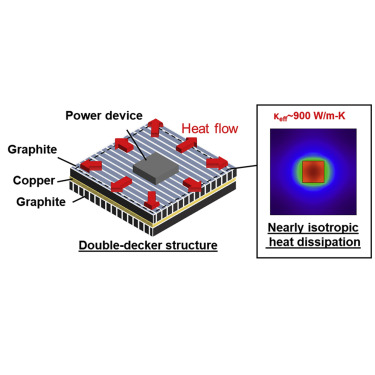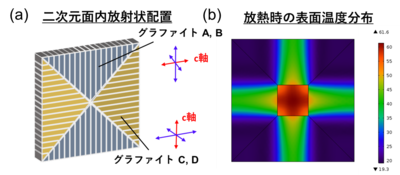


Tokyo Univ: Achieves high-efficiency heat dissipation for power semiconductors: Heat spreader
-For power semiconductors that handle high voltage and large current-
University of Tokyo Graduate School
Professor Junichiro Shiomi
The research group has developed a highly efficient heat dissipation structure for power semiconductors that handle high voltage and large current.
It can be used as a heat spreader that is sandwiched between a heating element and a heater to diffuse heat.
For power semiconductors
Highly efficient heat dissipation structure
This was achieved by using relatively inexpensive graphite and performing three-dimensional heat flow control.
Achieves both high heat dissipation efficiency and low cost
High integration of next-generation power semiconductors,
It is expected to lead to cost reduction.
High thermal conductivity / heat spreader:
With the increase in output and miniaturization of power semiconductors
A heat spreader with a higher thermal conductivity is required than copper, which is generally used.
Thermal conductivity of graphite:
The thermal conductivity of graphite is
High in the in-plane direction,
Because it is low in the direction perpendicular to the plane
Graphite could not be used “for power semiconductors that require isotropic heat dissipation”.
Research group:
We devised a method to make graphite have isotropic and high thermal conductivity by heat flow control.
resulting in,
The structure in which two graphite materials with different orientations are stacked in a three-dimensional space
It was found that it has more than 1.5 times higher heat dissipation performance.
Results of heat dissipation experiment:
Using this, a device heat dissipation experiment was conducted in a three-dimensional space.
The thermal conductivity in the heat dissipation experiment
At 900 watts / meter Kelvin,
It showed the same performance as the isotropic material.
The thermal conductivity of existing copper remains at 400 watts / meter Kelvin.
New switch
Realizes an ultra-high performance heat spreader by three-dimensional heat flow control using graphite
-Expected to be used for high-efficiency heat dissipation of power semiconductors-
Announcement point:
◆ The thermal conductivity of graphite is high in the in-plane direction, but low in the perpendicular direction.
Therefore, it was difficult to “use power semiconductors (Note 1) that require isotropic heat dissipation for thermal management”.
◆ “Graphite material in different directions” was processed and assembled three-dimensionally.
Further, it was integrally fired with copper and joined.
As a result, we have succeeded in effectively imparting isotropic heat dissipation.
◆ A heat dissipation test was conducted to simulate mounting.
“Very high heat dissipation performance equivalent to isotropic material with thermal conductivity of 900 W / m-K” has been achieved.
https://www.t.u-tokyo.ac.jp/foe/press/setnws_202110221318571011060492.html
Ultra-high-performance heat spreader based on a graphite architecture with three-dimensional thermal routing
Summary
To meet the increasing demand for highly efficient heat dissipation in power electronics,
a heat spreader
that has significantly greater isotropic thermal conductivity than the commonly used copper (400 W/m·K) should be developed.Although graphite
is a promising candidate because of its high basal-plane thermal conductivity,its application is restricted by its low c axis thermal conductivity.
This issue can be resolved
by transforming graphite into an isotropic thermal conductor by building a structure that can effectively route heat in all three dimensions.
Herein,
we develop a double-decker structurewith differently oriented graphite layers to realize high heat dissipation from a local heat source.
The critical issue of bonding the graphite layers is overcome by a high-temperature process using Cu as the binding layer.
The graphite/Cu composite efficiently
dissipates heat nearly isotropically and performs as well as an isotropic conductor with a thermal conductivity of 900 W/m·K.
ScienceDirect
https://www.sciencedirect.com/science/article/pii/S2666386421003398